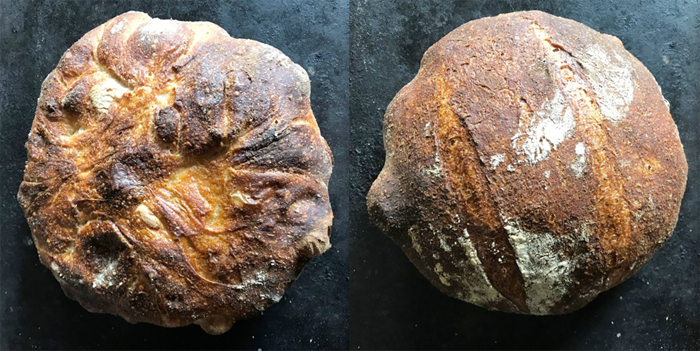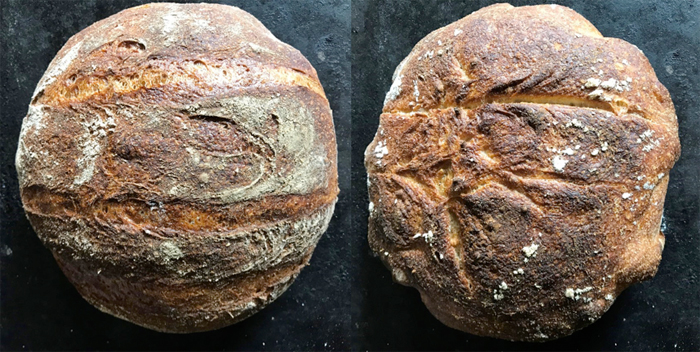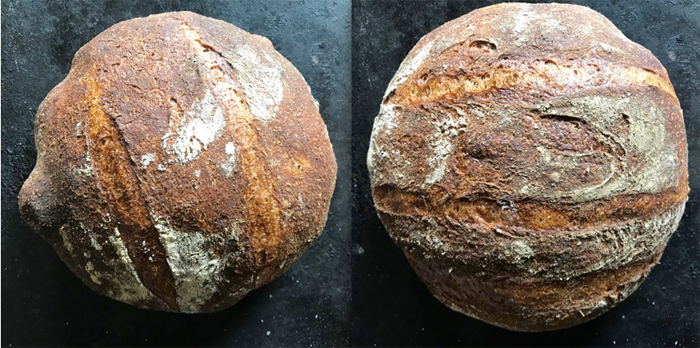Not Painter’s Block: Upheaval
Sandy Kinnee
April 2020
Straight away what I am experiencing is neither writer’s nor painter’s block. But it is downtime, flat out. I am playing with the cat and baking sourdough bread. This is about the best I can do during such a time of uncertainty. Upheaval is what I am suffering from and it makes a certain frustrating logic that I am not painting, not writing.
Fortunately, I do not have the energy it would take to bang my head against the wall.
This is a time to sleep, make bread, chase the cat. Anyway, that is how I am feeling. It is a confusing time. My sanctuary, cum studio, no longer exists. It is gone, the large reliable studio, that secure cocoon which provided a barrier from the everyday world, a safe space where I could dream in three dimensions. That atelier evaporated, it is gone, the lease was up for renewal and I could no longer justify what shouldn’t seem a luxury, but simply cost more money than I had. Over the years I worked in that magnificent and ample space, it was at very least a mental health asylum. In that studio my only concerns were between me and the prone canvas. What conversations we shared.
I went into the warehouse studio with my eyes fully open to the obvious fact that aside from myself, no one needed fifteen-foot swaths of cotton duck slathered with colors. No one has wall space for these too-large artworks. Yet, I painted them for years to the exclusion of all else. I painted them and the bright canvases filled me up. I painted them until the financial reality and the termination date of the lease loomed. The lease agreement would have been for another three years. I had previously leased the warehouse five sets of three-year periods. It was time to reconsider not the need to create big paintings, but my ability to pay the lease, utilities, and still eat and put gas in the car for my ten-mile drive to and from the studio. In any case, the warehouse studio is no more. I have
vacated the facility and handed my keys back to the landlord.
If it weren’t for the current Pandemic, I might possibly be sitting in one or the other of my studios, both at home and blankly glaring at empty sheets of paper. One studio is my brick carriage house, the other my winter studio designated as an etching studio. I am fortunate to have not one, but two studios. Still, I am in neither workspace. Instead, I am sitting in the dining room writing about a perfect storm, an overwhelming uncertainty and the need to eventually return to creating for myself.
I have cleaned the cobwebs, literal, as well as figurative, spider threads, out of both my home studios. I have sorted dried tubes of paint from those still squeezable, filed with workable colors. I have curated piles of old work, not seen in decades, tossing much into the trash. Those small paintings and drawings I am still holding onto sit in piles awaiting my judgment. What I feel when I think of these old pieces is that they are wasting space in my universe. They are contributing to the forces that are blocking me from beginning anew.
They are otherwise inconsequential elements contributing one more distraction from working in my studio. Eventually the health crisis will abate and either a new normal will be established or somehow, I can go back to the non-verbal dialogs I have with a paintbrush in my mitt and a piece of canvas or paper on the receiving end.
For now, I bake.
I don’t think I am the only artist distracted by turmoil. For me, creating art requires a state of mind and body that transcends the ordinary, the negative. Does that make sense?
There are certainly other artists who take inspiration from anguish, suffering, and uncertainty, making it their subject matter, motivation, or inspiration. Their way is also valid, but it is not my way.
It takes all kinds to make Art the vibrant shimmering rainbow that it is.
By nature, I prefer to work undistracted and in a positive state of mind.
Yesterday I baked bread again and gave the loaves away. Baking bread does not require me to look inside. When the loaves cool, I can give them to others who will appreciate them on various levels: as well-crafted objects that can and will be eaten, that will help sustain a body. Baking bread also answers my need to make something, while satisfying me when another person accepts the loaf. Maybe I am making transient, edible art. I am not making art, only baking.
I will make these loaves until I feel ready to enter the studio.
My daughter only a few weeks ago gave a talk on Necromancy and Battle Markers at the American Academy in Rome. This lecture happened during the onslaught of Covid-19 in Italy. She fortunately returned on virtually the last possible flight out of Rome. I was distressed until she landed back home.
My daughter reminded me that switching from creating art to making something less personal and more universally appreciated is how I respond to upheaval, mentioning of my similar and consistent responses to 9 11 and other public trauma. The morning of September 11, I immediately stopped making art in my studio, turning my attention to making paper. I made paper for weeks. Eventually, I gave the resulting paper to other artists, with the hopes they would make something positive. Did they? That was between them and the paper. Perhaps they also had paused making art. I was just making paper and passing the sheets along.
Paper is the reconstituting of destroyed and worthless materials. In my case, always articles of clothing. When hurricane Katrina struck New Orleans, I went to local thrift stores who were mounting aid efforts for flood victims. There, I purchased symbolic quantities of clothing from which to again make more paper. Although the Iraq War was unlike the hurricane or the attack of September 11, it produced angst and confusion, but intense trauma for those involved with the fighting. I did what I could by hosting a number of Iraq veterans in my studio for a Combat Paper Project weekend. Each veteran deconstructed his or her own decommissioned uniform. This shredding, by hand, of the combat uniform acts to neutralize the power of the negative associations by obliterating its former shape and transforming it into a positive entity: paper.
There are times when making art, at least for me, is best left until life has reached a point of equilibrium.
This time I am baking sourdough bread until things settle down.
◊
Sandy Kinnee is best known for his work with handmade paper since the early 1970s, he had for the past five years been exclusively painting fifteen-foot canvases. Unfortunately, his lease to the cavernous studio ended just as Covid-19 struck. Fortunately, he has a more modest studio at home, where he is currently hunkered down; baking sourdough bread and assembling small .GIF files from photographs of his paintings.
He won’t be going to Paris any time soon.



